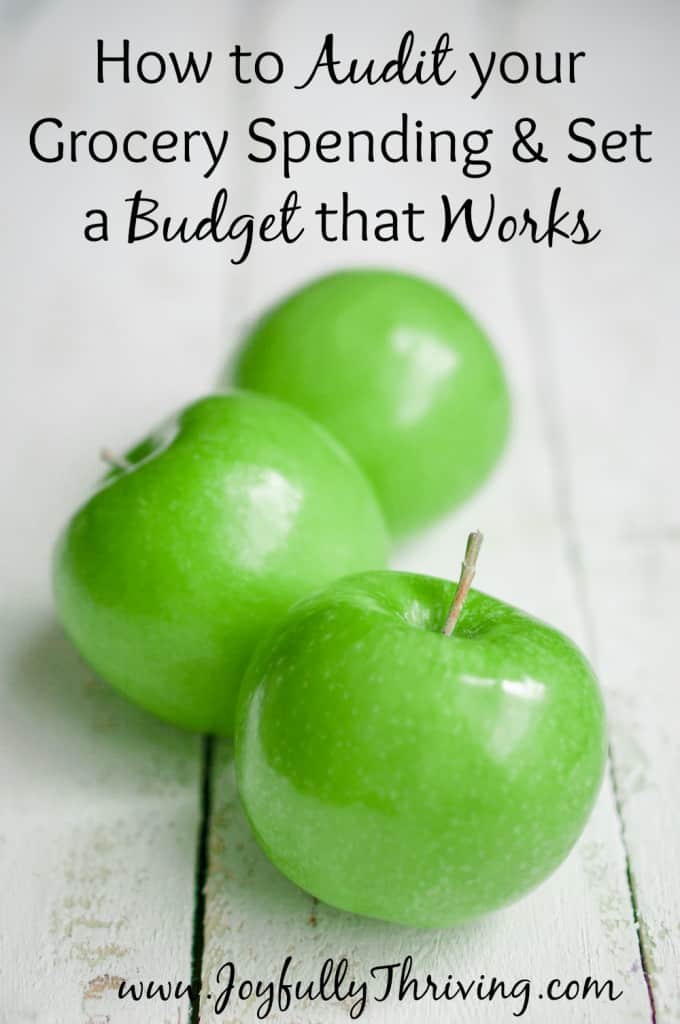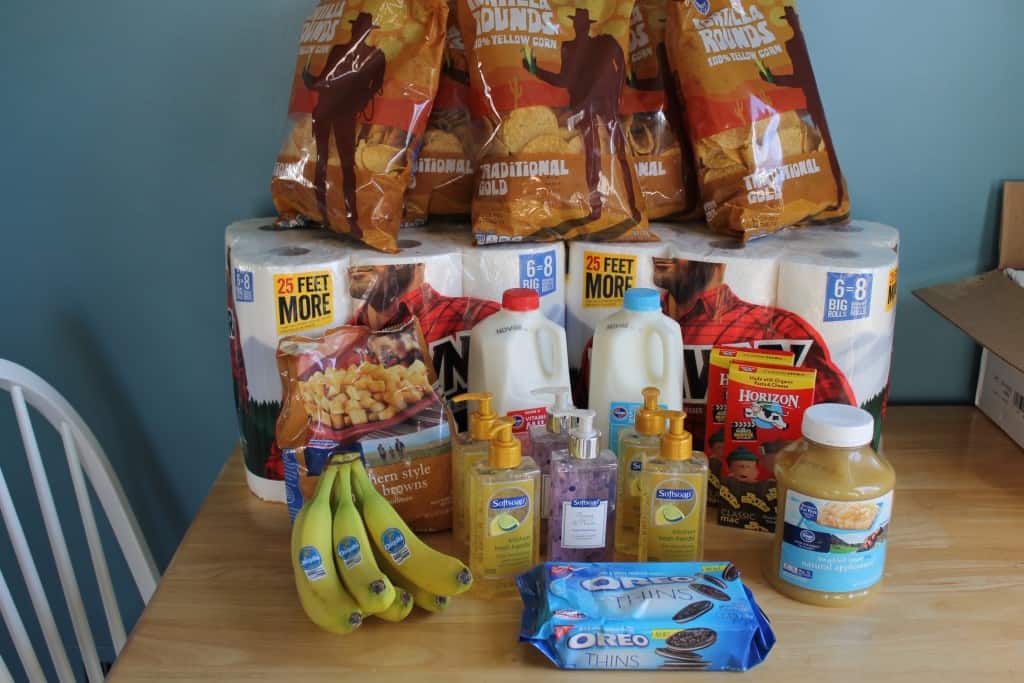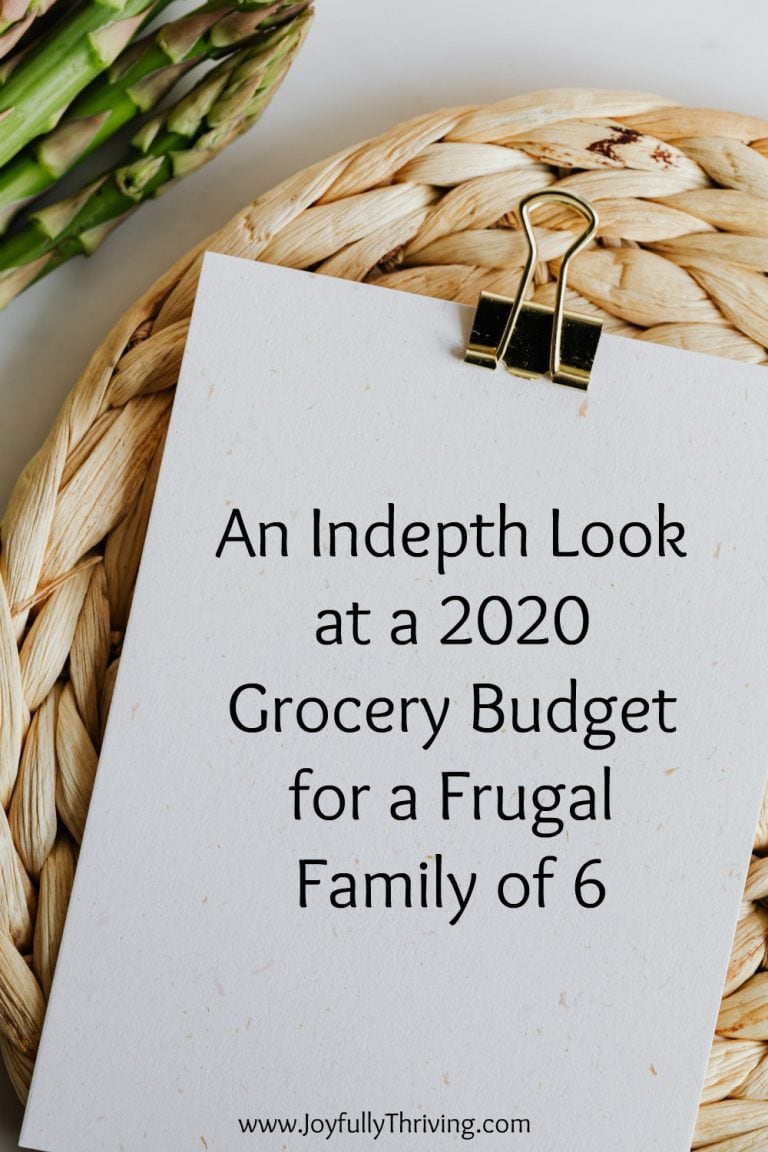Grocery Audits & Setting a Grocery Budget

The first time I read about a grocery audit was from Jessica at Good, Cheap Eats. It turns out I’d been doing this for years – without an official name! Still, Jessica had great insight and I’ve continued to refine my process over the years.
Every January, I sit down and work on my grocery budget. I look over my budget for the past year and set a new budget for the upcoming year. Some years, things change greatly and other years, not so much. I try to take into factor rising grocery costs, our family eating habits and the changing of couponing as well.
I find the process of auditing my grocery spending incredibly helpful. It doesn’t take long – usually only 30 minutes or so, but no more than an hour. I’ve simplified the process to 6 questions for those of you who are new to a grocery audit.
This post may contain affiliate links. As an Amazon Associate, I earn from qualifying purchases. You can read more in my disclosure policy.
Here’s how to conduct a grocery audit of your own.
1. Who’s in your family? This is the easiest step and where you need to start. How many people are you feeding and what are their ages? Obviously, a husband will eat more than your 4 year old little girl. If you have teenagers who are going through growth spurts, be aware of that fact as well.
2. What do you typically buy? Do you have any special food requirements or allergies in your family? Do you buy organic or avoid processed foods? Do you shop the sales and plan meals from those? Do you buy frozen meals?
3. What do you want to buy? Is there anything that you’d like to buy more – or less – of? For example, do you want to buy more fresh produce or higher quality meats? This year, I’m working on buying less processed processed foods and more vegetables.
4. How much do you currently spend? Do you know how much you actually spend on groceries? If not, save your grocery receipts for the month and see how they total up. Grocery shopping is one of the areas that I track the most closely so I’ll share my totals and audit below.
5. How much would you like to spend? Of course, we’d all love to spend less than $100 on groceries and apply the extra money to our other saving goals. Still, that’s not realistic for most of us and we do all have to eat! This can be the hardest area to determine. I recommend starting with your current budget and adjusting it $5 or $10 a week. Maybe that is an increase, due to your family’s eating habits. If you want to lower your budget, still work on gradual changes so you don’t feel overwhelmed!
6. What can you do to lower your spending? Regardless of where your budget is, I believe we all can find areas to save. Can you buy less processed snacks or only buy breakfast cereal that’s on sale? What can you make from scratch to save money? Can you switch stores to find one with better prices? Could you shop less frequently to avoid the temptation of overspending?
Here’s my grocery audit for 2015.
1. Who’s in your family? I currently cook for my husband, myself (pregnant through March) and an almost 2 year old boy with a good appetite. I’ll be nursing through most of the upcoming year and we will have another baby in diapers.

2. What do you typically buy? We’re not perfect and I do buy processed foods but we typically eat pretty healthy. I do shop the sales and cook from scratch quite a bit. Dairy (milk and cheese) are regular purchases as are fresh fruits. We eat meat at most evening meals so I try to stock my freezer when meat is on sale.
3. What do you want to buy? I want to buy less processed foods and eat healthier. For us, that means more meats and vegetables, as my husband is eating a South Beach style of meals right now.

4. How much do you currently spend? In 2015, I know exactly how much we spent on groceries. I’ve documented most of it on the blog in pictures. Over the course of the year, I spent $2470.38 during the year on groceries, toiletries, diapers and household cleaning supplies. This averages out to $205.87 a month. My budget was $200 a month. I stayed under budget 6 months of the year and went over budget the other 6 months. That tells me it is time to adjust our budget again.
According to the USDA food chart, my family (on the thrifty plan) should be spending $458.40 a month on groceries. I still think that’s high. Although, not as high as the liberal plan which says we should be spending $899.10 on groceries each month! Really? Yikes! I encourage you to take a look at the USDA chart and see where your family falls. It’s really interesting to view.
5. How much would you like to spend? Knowing that our family is changing this year, and that I have a growing little boy who enjoys eating, I’m going to raise our budget from $200 to $240 a month for 2016. Since I also include cleaning supplies, toiletries, paper products and diapers in this amount, that gives me more wiggle room as well.
Yes, I realize this is a low number but I also know that I have been couponing and shopping the deals for years to make this work. We are a one-income family so I want to be responsible and stretch our grocery budget as far as we can! Plus, I have a stockpile that helps me to feed our family healthy meals. Besides, I don’t like to shop for clothes so grocery shopping is my form of retail therapy. I love seeing what deals I can find and how much money I can save!

6. What can you do to lower your spending? Even though I’m going to raise our grocery budget, I can still lower spending by doing several things.
I will continue to bake our bread. I’m excited to share that I didn’t buy a single loaf of bread in 2015! Okay, I did buy a couple packages of hot dog and hamburger buns as well as clearanced pita bread, but I did make all our sandwich bread. Yay! Homemade bread really is easy, cheap and so delicious. Here’s the recipe I use for our homemade bread. I’m going to continue making our own yogurt, too, since it’s so easy to do so in the slow cooker. I estimate that these two substitutions (conservatively) save our family between $50 and $100 a year.
I need to watch for lowest price sales on meat and stock our freezer when I see those.
Since I lump all these things together, I will continue watching for sales on toiletries, paper products and diapers, to stretch my food budget further.
I am going to be intentional about using different coupon apps to earn money back on grocery purchases. Any money I do earn, I will put back into our grocery budget for more flexibility with our spending.
I need to shop our pantry to use what we already have and do a big freezer cooking session (before the baby comes). I know we have lots of miscellaneous grocery deals that have cluttered up my teeny kitchen pantry so I need to sort through them and use them up before buying anything new.

Now that I’ve shared my grocery audit, it’s your turn to give it a try! I’d love to hear what your grocery budget is for the upcoming year.
Finally, please remember that my budget will probably not work for you, nor will yours work for me. We all have to set a budget that works for our family size and location and eating habits and adjust from there!
To you have any additional tips for creating a grocery budget that works?




This is a great post! I started recording our spending this year and for our family of 4 I think we probably hover around the low-cost to moderate-cost plan. But, at the same time, I stock up when things are on sale and will spend a large chunk of money for that sale but then won’t have to buy it again for a long time (toilet paper, steaks, etc.) I’ll have to come back to this in a few months and review it again.
I do the same, Vera. I like having the flexibility to stock-up when great deals come along and not worrying about it for awhile. Grocery budgets vary so much based on family size and location and food purchases, but I find it fascinating to compare budgets…and I’m so glad you found this post helpful!
Great idea! This fall I reigned back in our budget (not by much, but a little) and we still come in at $350 a month for (quite literally) the same size family. That includes all of our toiletries too. Some weeks I spend less and use the overflow for something else so I don’t keep a good handle on exactly what we spend over the course of the year. I shop mostly at Aldi and Meijer and rarely use coupons though so I’m sure if I was more intentional I could save more!
I do the same, Kate, with my overflow. It’s one of the main reasons I love having a monthly budget instead of a weekly one! Aldi is across town, so an occasional store for me, but Meijer is my weekly store of choice. Mperks is a great place to start with savings. It does take time, but I believe the the savings are worth it! And with new little ones on the way, every penny saved really adds up…what with all the new diapers, we’ll both be buying! 🙂
Oh man, I have to check out that chart. We easily spend over $1,000/month with two teenagers and multiple food sensitivities. You are rocking it!
Food sensitivities raise lots of different grocery issues, Jayleen! The USDA chart is very interesting…and I love finding ways to save our family on our grocery budget!
That USDA chart is sure interesting. I think we’re pretty on-par with our spending (especially considering that we live in Alaska, which is typically more expensive than the lower 48). I love the idea of having a good sit-down think about our food spending. Thanks for the encouragement to take stock!
Isn’t it, Janeen? I can only imagine your grocery bills, what with living in Alaska! It makes the fact that you are paying off your mortgage early even more amazing! Have fun taking stocking – and planning ahead for the next year!
That’s a sweet family picture from Christmas! I didn’t know about the USDA chart, but I just checked it and it makes me feel a little better about my grocery budget! I keep it at $65 or less a week (not including diapers), but I have never added up what I spent for an entire year. One of my goals this year is to buy more meat on sale and stocking up and making more breakfast foods from scratch. Looking forward to seeing your grocery posts in 2016!
Thanks, Emily! I think the USDA chart can make anyone who is even somewhat a frugal shopper feel better about her budget! 🙂 That’s a great goal for weekly, and to make more from scratch. I’m with you, Emily, on buying more meat when it’s on sale. In fact, I almost bought more hamburger today but I think I already have 20 pounds in the freezer so I’ll wait a bit.
You look so adorable in your Christmas photo! I love it! Nothing to do with a grocery budget audit today, but I had to comment on your darling growing family! I wish you guys the most wonderful year, filled with unspeakable joy, your hearts desire and peace deep within! Blessings Kristen!
Aw, thank you! We’d been up late the night before on Christmas Eve and up early on Christmas Day, but I set up the tripod because I wanted a family picture of us in front of our own tree on Christmas Day. Thank you for your warm wishes, and I pray the same joy for your family this year as well!
I love this. Our grocery budget (since moving to Chicago half way through the year) has been $500. Still below the USDA frugal guidelines for our family size, but even then I’d love to lower it more.
I’m working on adding more beans to our meals as we do a lot of meat, veggies, and fresh produce here, as well as knowing some of our gluten-free products are more expensive. We also didn’t really have much of a stockpile with moving so I’m slowly trying to build that up and bring down our budget. Short term my goal is to move towards $450 a month and eventually get down to $400. With a baby due in July and me still suffering from morning sickness so not being able to put much effort into grocery shopping lately we’ll see how well this plan works.
I also know being more intentional about meal planning and getting some freezer meals prepped for those extra tiring and busy days is important to my success as well.
I think every woman gets a buy when they are suffering from morning sickness like you have been, Alisha! Plus, as you said, you have some tough adjustments. You don’t have a stockpile after moving, you eat gluten free AND you now live in an area where grocery prices are much higher! I think you have great goals of slowly bringing that amount down. I know you can do it! When I menu plan and intentionally use my freezer, our meal bills are lower too. I’ve been working through what is in our freezer this past week so I can prepping freezer meals again for once our baby is born in March.
Wow, your budget is incredible and inspiring. I easily spend double what you do in a month plus we raise chickens for eggs and eat lots of frozen venison. Where is my money going? I’m going to take your suggestion and do an audit since I have all of our grocery receipts from the last year. I suspect a lot is going to beverages… juice pouches, soy milk, seltzer water, etc. That’s a good place to start, right?
I think beverages is a great place to start, Leah! We live in the Midwest, where dairy prices are really low. The only beverages I buy are milk and the occasional container of juice (when I can get it for $1 or less). We’ve tried to cut out pop and any other beverages, too, for health reasons – and money saving ones! I’ve thought about raising chickens but am not sure I’m up to it. I’m impressed that you do, Leah! 🙂 Audits are a great way to figure out where your money is going and see where you can save. Oh, and like I said, I’ve been bargain shopping a long time to keep my budget this low. Lots of time and practice invested, but I like doing it – and it’s worth the savings to me!
I’ve been considering raising chickens now that we live in a place where I could. I don’t think this is the right season in life for us to do so, but one day I really hope to. Farm fresh eggs taste so much better but here in the Chicago suburbs people easily charge $5-6 a dozen just because of location, which is crazy expensive to me.
Beverages do get expensive. We use almond milk due to some lactose intolerance and that definitely adds up in comparison to dairy milk. We avoid juice and pop for cost and health reasons as well (except for the massive amounts of 7up I’ve been consuming to stay hydrated through this spurt of morning sickness). Those beverages add up fast though.
The other part to consider on that usda chart is it probably assumes parents work and kids eat at school. My husband eats out one lunch a month but our grocery budget pays for ALL meals and snacks for the 5 of us. If your husband takes his lunch to school then your budget pays for all meals for the 4 of you.
Do you have any idea how the chart compares to food stamps? Just curious.
I have been waiting for this post and thought you should increase your budget because you are a family of 4 now. That usda chart is unbelievable. I thought my budget was really high because we live in the West and do try to eat healthy. But my budget is not even close to the low amount on the chart. I do track just food not toiletries so know exactly what I spend. Your budget is so interesting to me because it is more than food.
My budget was set this year trying to slightly decrease what we paid the year before. It turned out almost exactly what we paid the year before. Considering price increase of eggs etc I was disappointed it wasn’t lower but glad it wasn’t higher. I am keeping my budget the same this year and am going to try harder to decrease it.
The USDA chart amazes me, too! What do they assume people are earning if they are spending that much on food? And good point about lunches out! I’m sure you are right. Even though St. Paul’s has an excellent hot lunch program (with cooks), Andy’s been taking his lunches this year, as part of our healthy eating changes. I’d like to do a comparison to food stamps, but it’s tricky to find an accurate comparison. I’m going to keep looking because I’ve always been curious about that, too. And yes, with price increases (especially on eggs!), good for you at staying under your budget. One of these days, maybe I’ll track toiletries and cleaning supplies separately, but since I buy so many of them when I’m grocery shopping at Meijer and Kroger, for now, it makes sense to me to track them together. We’ll see how it goes this year! I’m eager to try my hand at using some different coupon apps to earn some extra grocery shopping money, too. Here’s to another good year – for both of us – of grocery shopping!